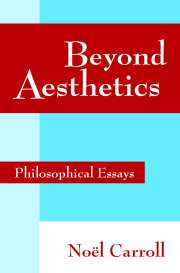Book contents
- Frontmatter
- Contents
- Foreword by Peter Kivy
- Introduction
- PART I BEYOND AESTHETICS
- PART II ART, HISTORY, AND NARRATIVE
- Art, Practice, and Narrative
- Identifying Art
- Historical Narratives and the Philosophy of Art
- On the Narrative Connection
- Interpretation, History, and Narrative
- PART III INTERPRETATION AND INTENTION
- PART IV ART, EMOTION, AND MORTALITY
- PART V ALTERNATIVE TOPICS
- Notes
- Index
On the Narrative Connection
Published online by Cambridge University Press: 19 January 2010
- Frontmatter
- Contents
- Foreword by Peter Kivy
- Introduction
- PART I BEYOND AESTHETICS
- PART II ART, HISTORY, AND NARRATIVE
- Art, Practice, and Narrative
- Identifying Art
- Historical Narratives and the Philosophy of Art
- On the Narrative Connection
- Interpretation, History, and Narrative
- PART III INTERPRETATION AND INTENTION
- PART IV ART, EMOTION, AND MORTALITY
- PART V ALTERNATIVE TOPICS
- Notes
- Index
Summary
Narrative is a topic of increasing interest across the humanities and the social sciences today. Even philosophers like Richard Rorty and Alastair MacIntyre invoke it, often against something they call theory. However, although the notion of narrative frequently figures in many discussions in the university, it is not often defined. The purpose of this essay is to advance a characterization of our ordinary concept of narrative in terms of one of its crucial ingredients, and to explore some of the ramifications of that definition in light of how we might begin, in part, to understand narrative comprehension.
Of course, narratives come in many different sizes and shapes. What is called a narrative history, for example, may mix different expositional forms, including not only narration, but argument and explanation. Likewise, a novel may contain elements of commentary, description, and decoration in addition to strictly narrative elements. It is not the purpose of this paper to define such large-scale units of discourse. My aim is much more modest. I would like to attempt to define something more discrete – what I call “the narrative connection.”
I suspect that when we call more large-scale discourses, such as histories or novels, narratives, we do so because they possess a large number of narrative connections or because the narrative connections they contain have special salience or a combination of both. I will not speculate on what proportion of narrative connections a discourse must possess or on what degree of salience said connections must exhibit in order for a large-scale discourse to be called a narrative. At present, I am only concerned to characterize the nature of the narrative connection.
- Type
- Chapter
- Information
- Beyond AestheticsPhilosophical Essays, pp. 118 - 133Publisher: Cambridge University PressPrint publication year: 2001
- 25
- Cited by



